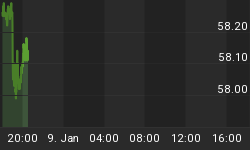For some sometime now I have been warning that it is my belief that the Australian economy reached its peak a while ago and that the signs of decline were ominous. It now looks that recession might be much closer than many economists realise. We now find that in the March quarter companies were operating at 83 per cent of capacity. This is one of the highest levels ever recorded and strongly suggests that monetary policy has been driving output beyond its capacity to meet demand.
As is always the case in these circumstances our excess utilisation of capital is being aggravated by an emerging shortage of skilled workers and the appearance of bottlenecks. An additional and important factor that is being overlooked is that productivity has been pretty flat for sometime now. Combined with the other factors, this is more evidence that a recession might be on the horizon despite the resources boom, for which we can largely thank China's monetary induced 'dash for growth'.
Some economists may think that the record investment in machinery and buildings during the March quarter is a sign that further investment can ward off inflation and increase output. This is another old economic fallacy that seems to emerge during every boom and one that has been noted for some 200 years. It needs to be endlessly pointed that labour shortages and bottlenecks are never indicators of future inflation because they are in fact caused by inflation.
However, the ACCI's chief executive Peter Hendy said that intensive competition was driving down selling prices, suggesting that inflation was being held in check. That this could mean that prices were being checked by the emergence of recessionary forces evidently did not occur to Peter Hendy and his advisors. Moreover, he is making the common mistake of confusing inflation with rising prices when in fact it has been surging beneath the surface of the economy for years.
If recessionary forces (sometimes called real economic forces) are beginning to emerge this could explain why the latest survey showed that manufacturing slowed down in April and also why the Performance of Manufacturing Index is barely breaking even at 50. Further evidence of an impending recession was provided with news that manufacturing was shedding even more labour. This is not incompatible with an increase in the aggregate demand for labour. I stressed a number of times in 2000 that though the demand for labour in the US was growing unemployment was rising in the manufacturing sector, clearly indicating that a recession was underway.
It seems that the only industry sectors that are still showing some strength are mainly textiles, food and beverages, footwear and clothing. One should carefully note that these industries are at the lowest stages of production and are thus the usually the last to feel the effects of an economic contraction.
Justifiable attention has been drawn to monetary tightening by the Reserve. Unfortunately no attention at all has been paid to its outrageous monetary expansion. Since March 1996 to January 2006 M1 grew by 114 per cent. This is a massive increase. Moreover, monetary growth has been comparatively flat since last June.
Even if the Reserve were to significantly expand credit it might not be sufficient to keep recession at bay, unless it tried to repeat its 1999 performance when M1 grew by 9.5 per cent and from January 2000 to December 2000 it rocketed by a criminal 22 percent. Given such magnitudes today I think it likely that the economy would respond with a rapid increase in the CPI and swift increase in the current account deficit followed by a sudden application of the monetary brakes.
At least economists realise there is a time lag between a monetary a slowdown and a consequent slowdown in manufacturing output, though it seems to be rarely noted in our media. Combine this with the possibility that China's central might tighten credit in the face of rising malinvestments and emerging bottlenecks and things begin to look even gloomier.
More than 175 years ago John Stuart Mill described the frenzied process of the boom as such that
... an increase of production really takes place during the progress of depreciation [inflation], as long as the existence of depreciation is not suspected; and it is this which gives to the fallacies of the currency school ... all the little plausibility they possess. But when the delusion vanishes ... those whose commodities are relatively in excess must diminish their production or be ruined: and if during the high prices they have built mills and erected machinery, they will be likely to repent at leisure. (John Stuart Mill, On the Influence of Consumption on Production from the Collected Works of John Stuart Mill Vol. IV, University of Toronto Press 1967, London: Routledge & Kegan Paul).
A final note is in order here: Should the recession strike deeply before the next federal election the Government will find its exaggerated claims for its labour reform legislation thoroughly discredited by rising unemployment. This would give an incoming labor government the moral and political authority to drastically alter the legislation or even repeal it. Should this happen then much of the blame should be sheeted home to the HR Nicholls Society whose bumbling advice in this matter has had negative ramifications.
















